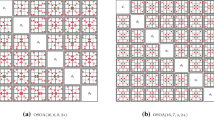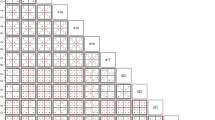Abstract
Space-filling designs are crucial for computer experiments. The quality of a space-filling design can be appropriately reflected by its stratification properties. In a recent paper, Tian and Xu (Biometrika 109(2):489–501, 2022) introduced the concept of a space-filling pattern to properly characterize a design’s stratification properties on various grids. In this study, we generalize the space-filling pattern using arbitrary orthonormal contrasts. We also propose a new pattern called the two-dimensional projection pattern to capture the stratification properties of balanced designs in two dimensions more comprehensively. We derive some theoretical results for both patterns and show that they are easier to compute and apply to a wider range of designs. We further show the use of the two patterns in constructing space-filling designs based on existing strong orthogonal arrays.
Similar content being viewed by others
References
Chen G, Tang B (2022a) A study of orthogonal array-based designs under a broad class of space-filling criteria. Ann Stat 50(5):2925–2949
Chen G, Tang B (2022b) Using nonregular designs to generate space-filling designs. J Stat Plan Inference 221:201–211
Cheng S-W, Ye KQ (2004) Geometric isomorphism and minimum aberration for factorial designs with quantitative factors. Ann Stat 32(5):2168–2185
Cheng C-S, He Y, Tang B (2020) Minimal second order saturated designs and their applications to space-filling designs. Stat Sin 31(2):867–890
Fang K-T, Lin DKJ, Winker P, Zhang Y (2000) Uniform design: theory and application. Technometrics 42(3):237–248
He Y, Tang B (2012) Strong orthogonal arrays and associated Latin hypercubes for computer experiments. Biometrika 100(1):254–260
He Y, Tang B (2014) A characterization of strong orthogonal arrays of strength three. Ann Stat 42(4):1347–1360
He Y, Cheng C-S, Tang B (2018) Strong orthogonal arrays of strength two plus. Ann Stat 46(2):457–468
Johnson ME, Moore LM, Ylvisaker D (1990) Minimax and maximin distance designs. J Stat Plan Inference 26(2):131–148
Liu H, Liu M-Q (2015) Column-orthogonal strong orthogonal arrays and sliced strong orthogonal arrays. Stat Sin 25(4):1713–1734
Mckay MD, Beckman RJ, Conover WJ (1979) A comparison of three methods for selecting values of input variables in the analysis of output from a computer code. Technometrics 21:239–245
Owen AB (1992) Orthogonal arrays for computer experiments, integration and visualization. Stat Sin 2(2):439–452
Owen AB (1994) Controlling correlations in Latin hypercube samples. J Am Stat Assoc 89(428):1517–1522
Santner TJ, Williams BJ, Notz WI (2018) The design and analysis of computer experiments, 2nd edn. Springer, New York
Shi C, Tang B (2019) Design selection for strong orthogonal arrays. Can J Stat 47(2):302–314
Shi C, Tang B (2020) Construction results for strong orthogonal arrays of strength three. Bernoulli 26(1):418–431
Sun F, Wang Y, Xu H (2019) Uniform projection designs. Ann Stat 47(1):641–661
Tang B (1993) Orthogonal array-based Latin hypercubes. J Am Stat Assoc 88(424):1392–1397
Tian Y, Xu H (2022) A minimum aberration-type criterion for selecting space-filling designs. Biometrika 109(2):489–501
Tian Y, Xu H (2023) Stratification pattern enumerator and its applications. J R Stat Soc Ser B Stat Methodol 86(2):364–385
Wang Y, Sun F, Xu H (2022) On design orthogonality, maximin distance, and projection uniformity for computer experiments. J Am Stat Assoc 117(537):375–385
Xu H, Wu CFJ (2001) Generalized minimum aberration for asymmetrical fractional factorial designs. Ann Stat 29(4):1066–1077
Zhou Y, Tang B (2019) Column-orthogonal strong orthogonal arrays of strength two plus and three minus. Biometrika 106(4):997–1004
Acknowledgements
We are grateful to the referee editor and two reviewers for their insightful comments and constructive suggestions. This study was supported by the National Natural Science Foundation of China (Grant Nos. 12371259, 11971098, 12271166, 11901199 and 12061033) and the National Key Research and Development Program of China (Nos. 2020YFA0714102 and 2022YFA1003701).
Author information
Authors and Affiliations
Ethics declarations
Conflict of interest
The authors state that there is no conflict of interest.
Additional information
Publisher's Note
Springer Nature remains neutral with regard to jurisdictional claims in published maps and institutional affiliations.
Rights and permissions
Springer Nature or its licensor (e.g. a society or other partner) holds exclusive rights to this article under a publishing agreement with the author(s) or other rightsholder(s); author self-archiving of the accepted manuscript version of this article is solely governed by the terms of such publishing agreement and applicable law.
About this article
Cite this article
Zhang, X., Wang, Y. & Sun, F. Theory and applications of stratification criteria based on space-filling pattern and projection pattern. Metrika (2024). https://doi.org/10.1007/s00184-024-00964-2
Received:
Accepted:
Published:
DOI: https://doi.org/10.1007/s00184-024-00964-2




